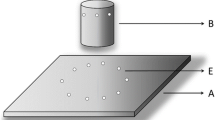Abstract
Mating between the two sexes in the leafhopperAmrasca devastans was inhibited by cineole vapors surrounding host plant leaves bearing the insects. There was a decline in the percentage of pairs mating and mated females fertilized. The vapors were not toxic and did not prevent the insects' arrival on the leaves. The cineole vapors inhibited the mating chiefly by interfering with the surface-mediated sonic communication between the sexes. The inhibition of mating was chemical specific since other volatiles, e.g., citral, were not as effective as cineole. Exposure to cineole vapors resulted in a decline in the sexual response of the females to the sonic signals of the male
Similar content being viewed by others
References
Claridge, M.F., andHowse, P.E. 1968. Songs of some BritishOncopsis species (Hemiptera: Cicadellidae).Proc. R. Entomol. Soc., London. A 43:57–61.
Claridge, M.F., andReynolds, W.J. 1973. Male courtship sounds and sibling species in theOncopsis flavicollis species group (Hemiptera: Cicadellidae)J. Entomol. B 42:29–39.
Ichikawa, T. 1977 Sexual communication of planthoppers, pp. 84–94,in The Rice Brown Planthopper, Food and Fertiliser Technology Centre, Asian and Pacific Region, Taipei, Taiwan.
Kumar, H. 1980. Sexual behavior and communication in the leafhopper,Amrasca devastans (Distant) (Homoptera: Auchenorrhyncha, Cicadellidae). PhD thesis. Delhi University, Delhi, India.
Kumar, H., andSaxena, K.N. 1978. Mating behavior of the cotton leafhopper,Empoasca devastans, in relation to its age, ovarian development, diurnal cycle and CO2-treatment.Ann. Entomol. Soc. Am. 71:108–110.
Mitchell, E.R. 1981. Management of Insect Pests with Semiochemicals: Concepts and Practice. Plenum Press, New York.
Ossiannilsson, F. 1949. Insect drummers: A study on the morphology and function of the sound-producing organs of Swedish Homoptera. Auchenorrhyncha.Opusc. Entomol. Suppl. 10:1–146.
Paul, R. 1976. Acoustic response to chemical stimuli in ground cricketsNature 263:404–405.
Ritter, F.J. 1979. Chemical Ecology: Odour communication in animals. Elsevier/North-Holland Biomedical Press, Amsterdam.
Rudinsky, J.A., andMichael, R.R. 1972. Sound production in Scolytidae: Chemostimulus of sonic signal by the Douglas-fir beetle.Science 175:1386–1390.
Rudinsky, J.A., andMichael, R.R. 1974. Sound production in Scolytidae: ‘Rivalry’ behavior of maleDendroctonus beetles.J. Insect Physiol. 20:1219–1230.
Rudinsky, J.A., Morgan, M.E., Libbey, L.M., andPutnam, T.B. 1974. Anti-aggregative-rivalry pheromone of the mountain pine beetle, and a new arrestant of the southern pine beetle.Environ. Entomol. 3:90–98.
Saxena, K.N., andBasit, A. 1982. Inhibition of oviposition by volatiles of certain plants and chemicals in the leafhopperAmrasca devastans (Distant).J. Chem. Ecol. 8:329–338.
Saxena, K.N., andKumar, H. 1980. Interruption of acoustic communication and mating in a leafhopper and a planthopper by aerial sound vibrations picked up plants.Experientia 36:933–935.
Saxena, K.N., andKumar, H. 1984. Acoustic communication in the sexual behavior of the leafhopperAmrasca devastans.Physiol. Entomol. 9:77–86.
Saxena, K.N., andSaxena, R.C. 1974. Patterns of relationships between certain leafhoppers and plants. Part II. Role of sensory stimuli in orientation and feeding.Entomol. Exp. Appl. 17:493–503.
Saxena, R.C., andSaxena, K.N. 1971. Growth longevity and reproduction ofEmpoasca devastans on okra fruit for laboratory rearing.J. Econ. Entomol. 64:424–426.
Shaw, K.C., Vargo, A., andCarlson, O.V. 1974. Sounds and associated behavior of some species ofEmpoasca (Homoptera: Cicadellidae).J. Kans. Entomol. Soc. 47:284–307.
Shorey, H.H., andMcKelvey, J.J., Jr. 1977. Chemical Control of Insect Behavior. John Wiley & Sons, New York.
Snedecor, G.W., andCochran, W.G. 1967. Statistical Methods. The Iowa State University Press, Ames.
Strübing, H. 1965. Das Lautverhalten vonEuscelis plebejus Fall, undEuscelis ohause Wagn. (Homoptera: Cicadena).Zool. Beitr. 11:289–341.
Traue, von D. 1978. Zur Biophysik dor Schallabstrahlung bei Kleinzikaden am Beispiel vonEuscelis incisus Kb (Homoptera: Cicadina: Jassidae).Zool. Beitr. 24:155–164.
Author information
Authors and Affiliations
Rights and permissions
About this article
Cite this article
Saxena, K.N., Kumar, H. Interference of sonic communication and mating in leafhopperAmrasca devastans (distant) by certain volatiles. J Chem Ecol 10, 1521–1531 (1984). https://doi.org/10.1007/BF00990321
Received:
Revised:
Issue Date:
DOI: https://doi.org/10.1007/BF00990321




